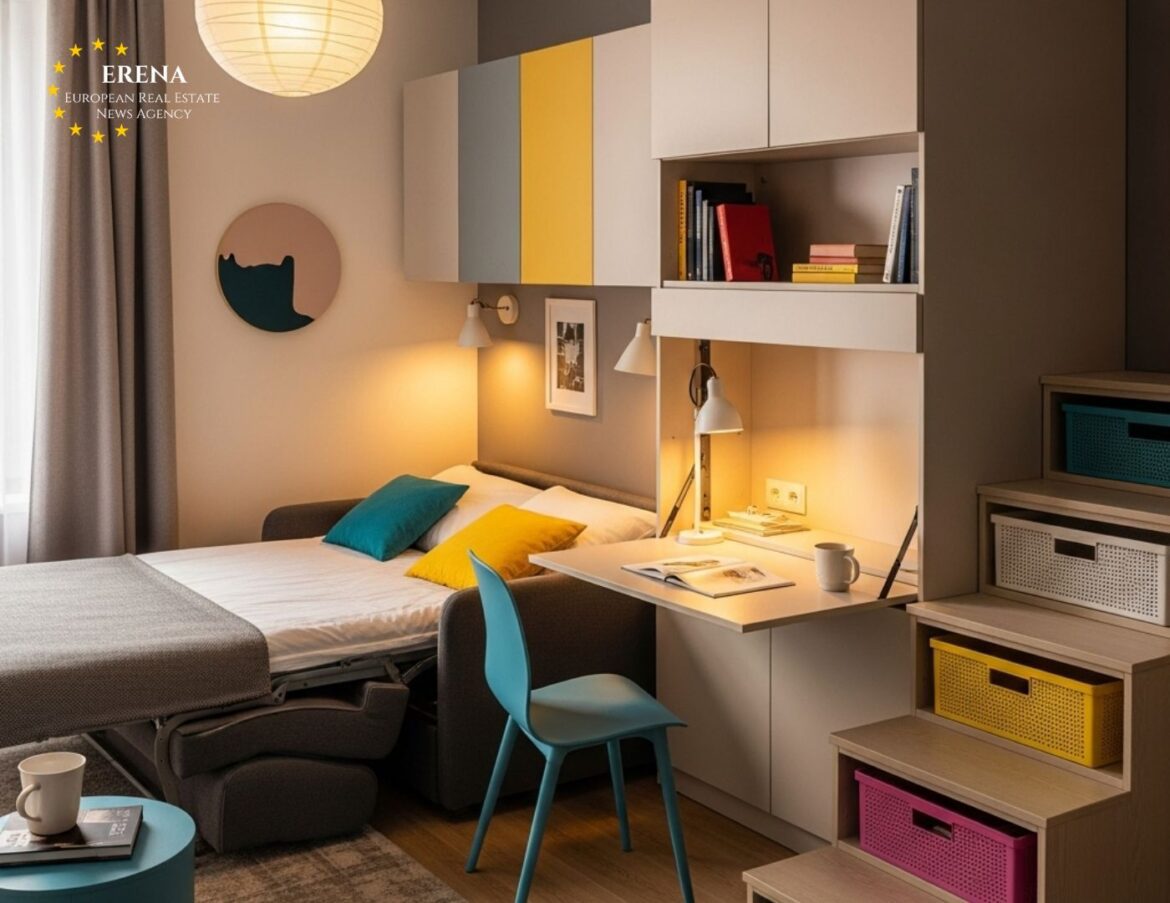As urban density increases across Europe and property prices rise, city dwellers are facing a growing challenge: making the most of limited living space. One of the most effective solutions to emerge in recent years is dual-purpose furniture—transformable, multifunctional, and space-saving. In a world where every square meter matters, such furniture has transitioned from a convenience to a necessity.
Urban Living: Shrinking Spaces, Growing Needs
According to Eurostat, the average apartment size in major European capitals is steadily decreasing. For example, in Paris, the average new-build home measures around 55 m²; in Amsterdam, 60 m²; in Berlin, 58 m²; and in Barcelona, 57 m². The issue is particularly pressing for renters, young couples, freelancers, and remote workers trying to balance comfort with functionality.
In this context of increasing urbanization and housing costs, multi-functional furniture is a logical and cost-effective choice. It helps optimize space without compromising on aesthetics or utility.
What Is Dual-Purpose Furniture?
Dual-purpose (or multi-purpose) furniture refers to items that serve two or more functions. Some of the most popular examples include:
- Sofa beds that serve as seating by day and transform into beds at night
- Fold-out dining tables that double as desks or compact sideboards
- Storage beds with drawers or lift-up mechanisms
- Wall-mounted desks that can be hidden when not in use
- Ottomans that double as storage units or coffee tables
Modern designs now also feature USB charging ports, adjustable heights, casters for mobility, and modular elements for customization.
Rising Demand in the European Market
According to Statista, the market for transformable furniture in Europe grew by 12% in 2024 compared to the previous year. Countries leading the trend include:
- The Netherlands, with compact flats in cities like Utrecht and The Hague
- France, especially Paris, where micro-apartments (25–35 m²) are common
- Germany, where Berlin and Hamburg are embracing micro-living
- Italy and Spain, where dual-purpose furniture is a staple in vacation rentals and urban apartments
Typical price ranges for multifunctional furniture:
- Quality sofa beds: €600–€1,500
- Lift-up storage beds: €500–€1,200
- Modular workstations: €200–€800
- Foldaway wall desks or convertible wardrobes: starting at €900
Key Brands and Design Innovations
Leading furniture brands have adapted their offerings to meet these evolving needs:
- IKEA continues to launch new series like LINNMON and BRIMNES, designed for small spaces
- BoConcept (Denmark) offers sleek, high-end multifunctional pieces
- Resource Furniture (Italy/USA) specializes in luxury transformable solutions
- LAGO (Italy) focuses on modular and suspended systems
- Muji and Nitori (Japan) inspire minimalistic, compact interiors that resonate across Europe
There is also growing interest in custom-built and DIY solutions, especially among eco-conscious consumers and design enthusiasts.
Sustainability and Smart Integration
More manufacturers are adopting eco-friendly materials, recycled components, and durable fittings. Features like soft-close mechanisms, magnetic latches, and integrated LED lighting are increasingly standard.
The next frontier is smart furniture—think folding tables with wireless charging, app-controlled beds, or furniture that responds to voice commands in smart homes.
Functionality and Quality of Life
For many city residents, dual-purpose furniture is not just about saving space—it’s about enhancing the quality of life. It appeals to:
- Remote workers needing a home office that disappears after hours
- Young couples who want to separate living and sleeping zones in a single room
- Seniors downsizing to smaller, more manageable homes
- Landlords aiming to optimize interiors for short- or mid-term rentals
Investment Value
Property investors are increasingly furnishing their units with multifunctional pieces to:
- Boost appeal for potential tenants
- Make small units feel larger and more livable
- Offer adaptable layouts for different user needs
This is particularly relevant in studios under 40 m², which in cities like Berlin, Amsterdam, and Madrid can rent for between €700 and €1,500/month, depending on location and finish.
Real-Life Applications Across Europe
- Paris: Studio apartments in the 3rd and 11th arrondissements often include wall beds and fold-out kitchens
- Berlin: New micro-apartment complexes come with built-in dual-purpose furniture
- Milan: Urban flats feature sofas that convert into bunk beds or beds with sliding partitions
- Barcelona: Short-term rentals are often fitted with hidden dining tables and retractable office setups
The Future of Compact Living
As living spaces shrink and lifestyles become more dynamic, flexible furniture solutions are becoming a central element of interior design. They enable small apartments to serve as homes, offices, gyms, and social spaces—all within a limited footprint.
Emerging trends include:
- Wall-integrated storage systems that blend seamlessly with decor
- Convertible outdoor furniture for balconies and terraces
- Tech-enabled pieces that adapt to the user’s schedule or mood
- Circular design principles to allow furniture to be reused or recycled
Conclusion
Dual-purpose furniture has moved from being a stylish choice to a practical urban necessity. As housing becomes more expensive and flexible lifestyles become the norm, these adaptable furnishings offer a smart, sustainable way to live well in tight spaces.
Key takeaways:
- Average apartment sizes in European cities are shrinking
- Multi-functional furniture helps maximize comfort without increasing square footage
- Demand is driven by urbanization, remote work, and changing living patterns
- Leading brands and designers are investing in modular, sustainable, and tech-forward solutions
- For property owners, investing in dual-purpose furniture enhances both property value and livability
In 2025 and beyond, dual-purpose furniture isn’t just a trend—it’s a vital tool for modern European living.

